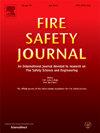Experimental study on the mechanical behavior of the elementary components of masonry walls at high temperature
IF 3.4
3区 工程技术
Q2 ENGINEERING, CIVIL
引用次数: 0
Abstract
Predicting the behavior of masonry structures under fire exposure and anticipating their fire resistance are critical for brick manufacturers. The fire performance of masonry walls depends on the behavior of components like bricks and mortars, both traditional and thin-layer, at high temperatures. Understanding this requires studying masonry from the material scale to full-scale walls. This paper examines the mechanical properties of terracotta and masonry mortar at high temperatures. It also investigates the compressive and tensile responses of masonry pairs, and the shear response of masonry triplets with fired brick and masonry mortars. The findings show that fired clay’s flexural and compressive strengths increase with temperature, while the Young’s modulus slightly decreases. Conversely, the flexural and compressive strengths of masonry mortar, along with the Young’s modulus, decrease significantly, losing nearly 80% around 700 °C. The compressive strength of masonry pairs follows the brick’s trend with temperature. However, both pairs and mortar show a similar decrease in tensile strength as temperature rises. The shear strength of masonry triplets declines to about 40% of its initial value at 600 °C. These results are crucial for developing nonlinear numerical simulations to understand hollow brick masonry walls during fires.
高温下砌体墙体基本构件力学性能试验研究
砌体结构在火灾作用下的性能预测和耐火性能预测对砖砖制造商来说至关重要。砌体墙的防火性能取决于砖和砂浆等构件在高温下的行为,无论是传统的还是薄层的。理解这一点需要从材料尺度到全尺寸墙体的砌筑研究。研究了陶土和砖石砂浆在高温下的力学性能。本文还研究了砌体对的抗压和拉伸响应,以及由烧结砖和砌体砂浆组成的砌体三联体的剪切响应。结果表明:烧制粘土的抗折强度和抗压强度随温度升高而增大,而杨氏模量略有降低;相反,砌体砂浆的抗折和抗压强度以及杨氏模量显著下降,在700°C左右损失近80%。砌体副的抗压强度随温度的变化而变化。然而,随着温度的升高,这两种材料和砂浆的抗拉强度都表现出相似的下降。砌体三联体抗剪强度在600℃时下降到初始值的40%左右。这些结果对于发展非线性数值模拟来理解火灾过程中空心砖砌体墙具有重要意义。
本文章由计算机程序翻译,如有差异,请以英文原文为准。
求助全文
约1分钟内获得全文
求助全文
来源期刊

Fire Safety Journal
工程技术-材料科学:综合
CiteScore
5.70
自引率
9.70%
发文量
153
审稿时长
60 days
期刊介绍:
Fire Safety Journal is the leading publication dealing with all aspects of fire safety engineering. Its scope is purposefully wide, as it is deemed important to encourage papers from all sources within this multidisciplinary subject, thus providing a forum for its further development as a distinct engineering discipline. This is an essential step towards gaining a status equal to that enjoyed by the other engineering disciplines.
 求助内容:
求助内容: 应助结果提醒方式:
应助结果提醒方式:


